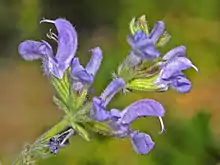| Salvia virgata | |
|---|---|
 | |
| Flower of Salvia virgata at the Orto Botanico di Brera | |
| Scientific classification | |
| Kingdom: | Plantae |
| Clade: | Tracheophytes |
| Clade: | Angiosperms |
| Clade: | Eudicots |
| Clade: | Asterids |
| Order: | Lamiales |
| Family: | Lamiaceae |
| Genus: | Salvia |
| Species: | S. virgata |
| Binomial name | |
| Salvia virgata | |
Salvia virgata (wand sage, southern meadow sage) is a perennial plant that is native to Asia and southeastern Europe. It is considered a noxious weed in many parts of the world.[1]
S. virgata is sometimes included within Salvia pratensis. Flowers grow in whorls of 4–6 with a blue-violet corolla (rarely white) that is 1 to 2 centimetres (0.39 to 0.79 in) long. The ovate to oblong leaves are dull green on the top surface, with the underside covered with glands and thick hairs.[2]
Notes
- ↑ "Salvia virgata". Germplasm Resources Information Network. Agricultural Research Service, United States Department of Agriculture. Retrieved 13 March 2012.
- ↑ DiTomaso, Joseph M.; Healy, Evelyn A. (2007). WEEDS OF CALIFORNIA AND OTHER WESTERN STATES, Volume 1. ANR Publications. pp. 885–889. ISBN 9781879906693.
External links
This article is issued from Wikipedia. The text is licensed under Creative Commons - Attribution - Sharealike. Additional terms may apply for the media files.